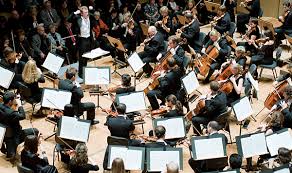The Mahler Chamber Orchestra
by Jennifer Bryce
On Saturday, 9th March, there was a sublime orchestral concert in the Adelaide Town Hall.

The Mahler Chamber Orchestra has its roots in the Gustav Mahler Youth Orchestra, founded by conductor Claudio Abbado in 1997. Members of the orchestra share a vision of being a free, democratic and international ensemble that unites to tour across Europe and the world. The present Mahler Chamber Orchestra was founded 21 years ago by the musicians themselves. It is an orchestra of 45 soloists from over 20 nations.

In this concert, there were two symphonies : Schubert’s 3rd – not well known, and Bruckner’s Symphony No. 4 (‘The Romantic’). The Schubert symphony was written when the composer was only 17, and it was not published during his short life time — he died at the age of 31.

Franz Schubert
During the allegro section of the first movement I became aware of superb clarinet playing: the principal clarinet plays a solo over syncopated strings — at first it is extremely soft and gradually it develops to a full orchestral sound. Whilst beautifully controlled, the clarinet was played in an almost ‘folksy’ style — singing above the strings and the player himself was far from sedate, moving as much as possible in the confines of an orchestral chair. During the playful minuet movement of this symphony the players smiled at each other.

Vincente Alberola, principal clarinet player
This orchestra’s sound is characterised by a chamber music style of ensemble playing from alert and independent musical personalities. The words of the concert program were borne out. The players ‘bring a palpable collective musical intelligence and evenness of skill to whatever they play’. The orchestra was conducted by Daniel Harding.

Daniel Harding
Still only in his forties, Harding is renowned as an opera conductor at La Scala, Milan and he also conducts the Vienna and Berlin Philharmonic Orchestras. I was particularly drawn to the superb blending of the woodwind, and I have never before heard such precise and beautiful pizzicato.

Jaan Bossier, clarinet
Influenced, perhaps, by his opera experience, and speaking about the Bruckner, Harding talks of the ‘choirs’ of instruments in the orchestra: brass, strings and woodwinds. (Limelight Magazine, March 2019). He aims for these ‘choirs’ to be more ‘equal’ rather than, say, brass dominating in the fortissimo sections. Of the Bruckner, he has said that it is full of Austrian folk music – not just ‘monumentalism’. (Limelight Magazine,March 2019).

Anton Bruckner
When a piece of music, particularly a symphony, is based on some form of narrative it can be said to have a ‘program’. Symphony No. 4, which the composer himself labelled as ‘The Romantic’ is believed to follow a program: ‘Mediaeval city—Daybreak—Morning calls sound from the city towers—the gates open—On proud horses the knights burst out into the open, the magic of nature envelops them—forest murmurs — bird song —and so the Romantic picture develops further…’ (Williamson, John 2004, The Cambridge Companion to Bruckner, C.U.P., p.110). The symphony opens with a beautiful horn solo over shimmering strings, and throughout the symphony, particularly the 3rd movement, there is much suggestion of a rollicking hunt of nineteenth century landed gentry. In the 3rd movement came the cleanest, clearest pizzicato I have ever heard — the entire string section — violins, violas, ‘celli and basses — playing as one.

Mizuho Yoshi-Smith, principal oboe
At the end of the concert, after much applause, the members of the orchestra hugged each other. I recall that members of the Berlin Philharmonic did this after their concert in Sydney many years ago: confirmation that they are a team who love performing together.

Adelaide Town Hall, venue for the Mahler Chamber Orchestra concert
Jennifer, I am looking forward to reading this at leisure.
LikeLike
Thanks, Margaret!
LikeLike
Jenny your enthusiasm is so infectious – I almost feel I am there. Your descriptions of the playing are, as always, so details and quite fascinating. Thank you for sharing – I seem to learn so much with each post!
LikeLike
That’s great, thanks Helen. It was a memorable concert.
LikeLike
Wow, Jennifer. This is just another world and one complete unto itself. Thank you for sharing it withe me at least. Nice to know that they all meet up voluntarily too, because they love it.
LikeLike